Purpose
This job aid details the infotype screens utilized by the Benefits module in the Integrated HR/Payroll System. The infotypes covered include:
Actions (IT0000)
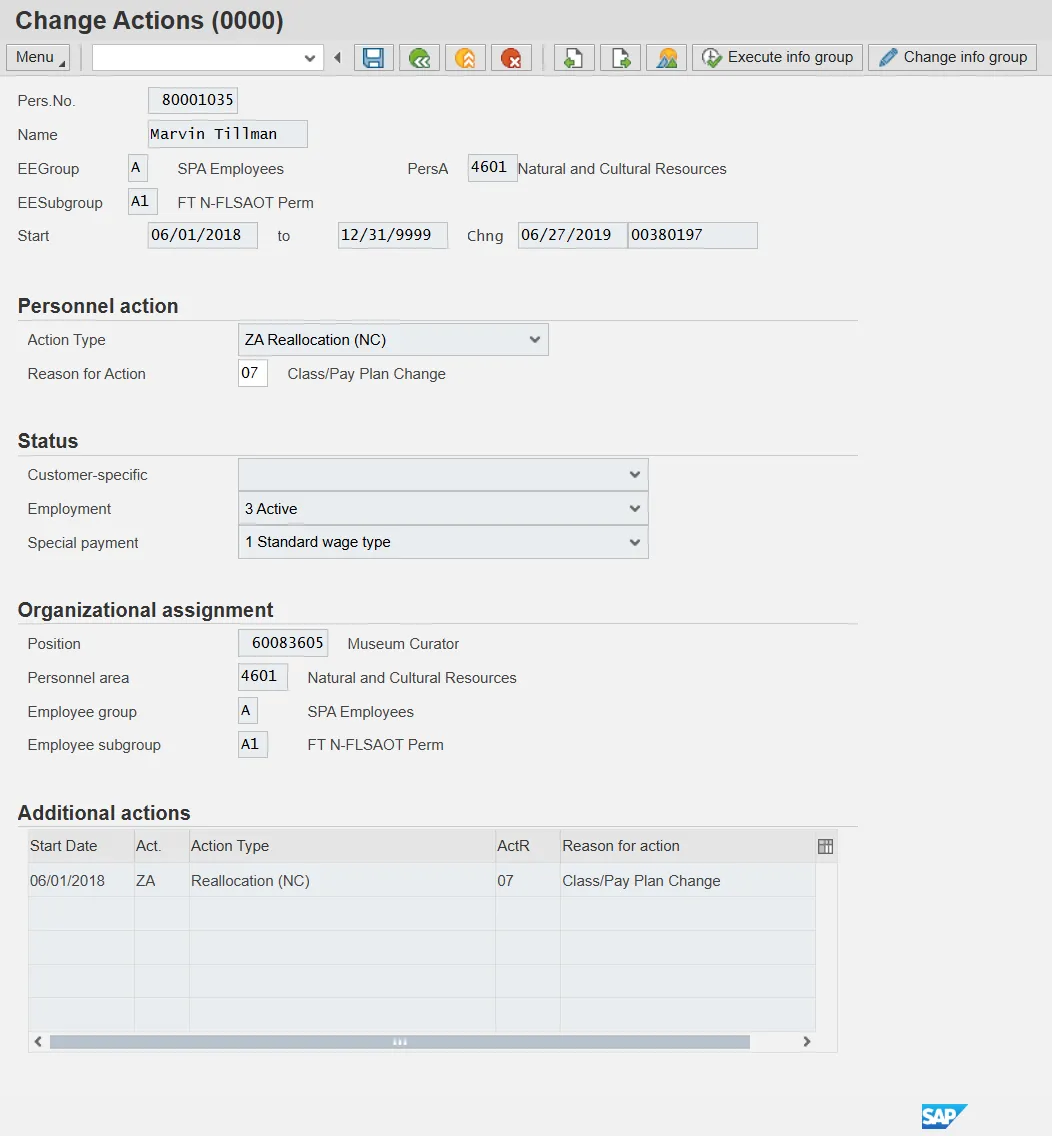
The Integrated HR/Payroll System simplifies the processing of complex personnel procedures, such as hiring a new employee, by using what are known as personnel actions. You can use personnel actions to:
- Hire an employee
- Change the organizational assignment of an employee
- Change the employee’s pay
- Set an employee’s status to early retiree or pensioner
- Document when an employee leaves or re-enters the enterprise
With the Actions infotype (0000), you can display an overview of all the important changes related to an employee, and you can then display the documentation of the most important stages that an employee passes through in your agency or division.
Field Definitions
| Field Name | Description | |
| Pers. No | The Orbit system-generated unique identifier for the employee | |
| Name | The employee’s name | |
| EE group |
Employee group identifies an employee’s employment status and expresses the relationship between the employee and the State of North Carolina. This field is used by the system to establish rules for calculating leave. Examples:
|
|
| Personnel area |
Defined by company code NC01 or NC02, represents the agency or department for whom the EE works. The field code is a four-digit alphanumeric character where the first two digits are the NCAS (North Carolina Accounting System) entity number and the last two digits, if applicable, represent second level entities often referred to a division, otherwise it will be ’00’. For example:
|
|
| EE subgroup |
Further defines an employee’s relationship to the State of North Carolina and used to define Fair Labor Standards Act (FLSA) exempt and non-exempt status, and their full-time or part-time status. This field, in conjunction with the EE group, establishes the type of payroll calculations. Examples:
|
|
| Start (date) | Beginning date of the information being viewed. | |
| To (date) | Ending date of the data being viewed; if the information is current, the “end of time” (12/31/9999) will be displayed. | |
| Action Type | Life cycle of an employee, hire, status change, leave, termination, etc. In the Integrated HR/Payroll System, actions sequence the presentation of infotypes to facilitate entry of data. | |
| Reason for Action | The reason for the action. | |
| Employment (status) |
There are three employment statuses:
|
|
| Position | Position number associated to the employee’s position. A position is described by a job and inherits planned compensation, EEO, AAP and other attributes from a job. A person holds a position. |
Adjustment Reasons (IT0378)
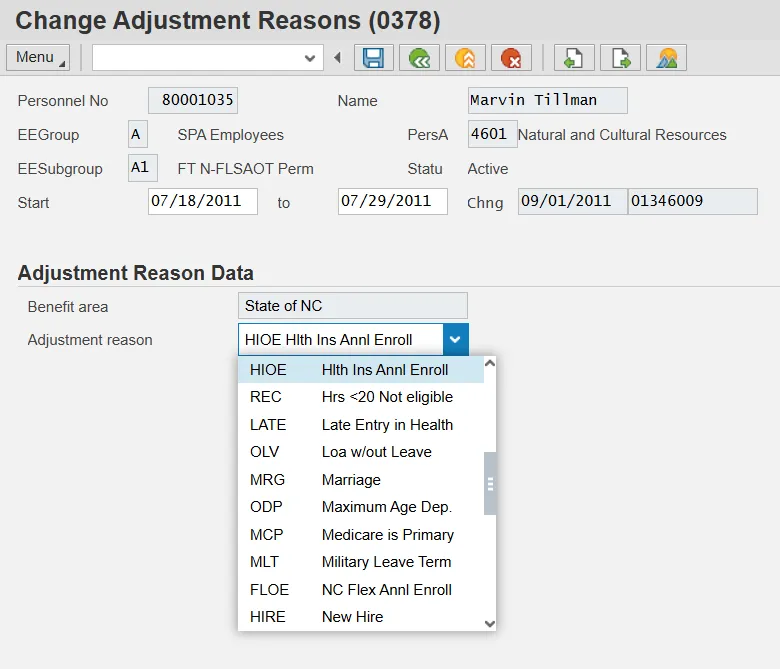
This infotype stores adjustment reasons that determine the changes employees can make to their benefits. The type of adjustment reason is the subtype of the record.
The validity of this record represents the period within which the employee can make changes to benefit elections. Thus, when an employee has one of these infotype records, the system produces a benefit offer in enrollment that is valid for the validity period of this record. The benefit offer allows a restricted set of changes to existing enrollments.
Note: The HR Master Data role will be able to create adjustment reasons for life-changing events.
Family Member/Dependents (IT0021)
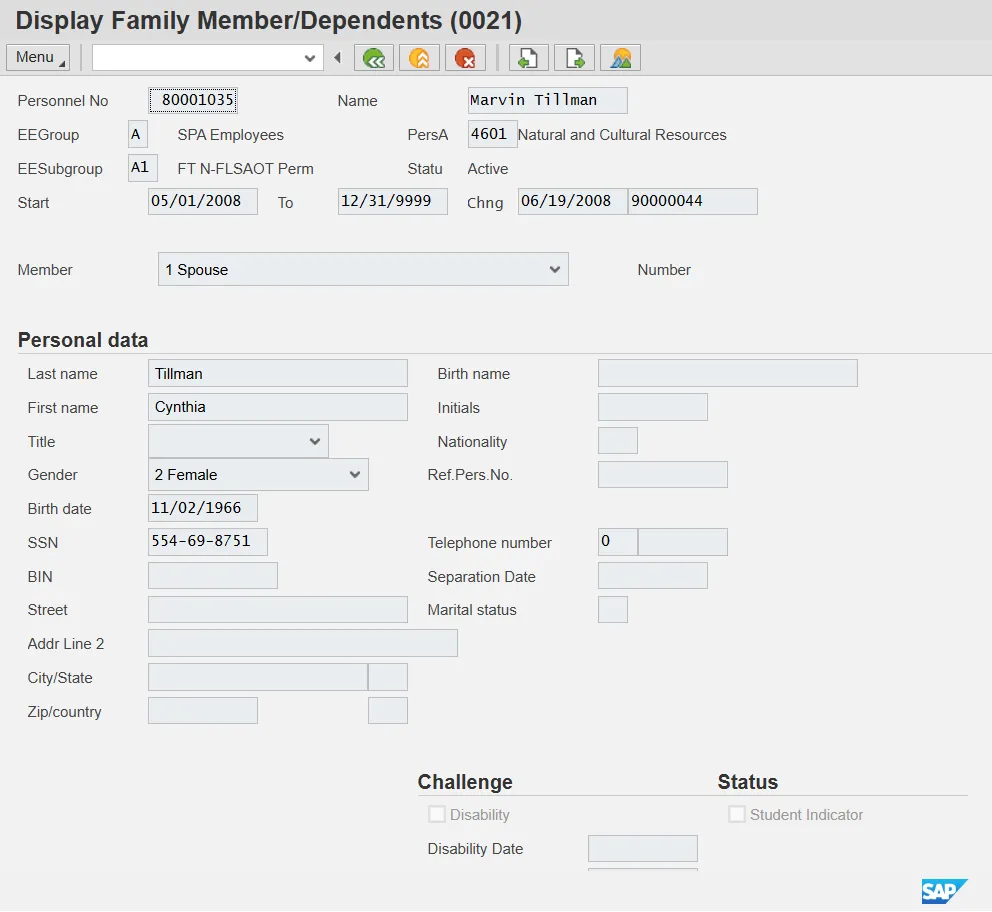
A Family Member/Dependent record must exist before employees can include family and related persons as dependents in their benefit plans.
The From field for the begin date of the record must be a date later than the Organizational Assignment (IT0001) record begin date or date of birth of the individual, whichever is the later date.
The Status and Challenge indicators are relevant to COBRA administration. If the person whose details you store here ever becomes eligible for COBRA, this information will define the parameters for COBRA participation.
There are seven entries for the subtype for this infotype including spouse, child, legal dependent, stepchild, divorced spouse, foster child, and court-ordered dependent. These family members are available as dependents.
Field Definitions
| Field Name | Description | |
| Personal data fields |
These fields contain the personal data of the family member or dependent. Please note the use of the following fields: Reference Personnel Number for Family Member - You can use this field to enter the testator's personnel number for pension payments to surviving dependents or the reference number of a family member to be used for storing additional data in the system. |
|
| Challenge (indicator) |
Disability Set this indicator if the family member is disabled. You can also indicate whether the person is partially or totally disabled by entering a percentage in the % field. When you set this indicator and create a new record for infotype Fiscal Data B (0101), the corresponding field in IT0101 is updated accordingly. You can either confirm this value or change it. Note that only the value in IT0101 has an impact on the tax calculation. Example: The Nr. of disabled children field in IT0101 is automatically filled in with 1 if you have specified that your child is disabled. |
|
| Disability date | The date of determination of disability status. | |
| Learned | The date the State of North Carolina learned of the disability status. | |
| Status (Student indicator) | The Status and Challenge indicators are relevant to for dependent children over 19 years old who are full-time students or for dependent children over 19 years old or 26 years old who are medically disabled. When these indicators are checked, the system allows the dependent to continue to be eligible for health plans. |
FSA Plans – Overview (IT0170)
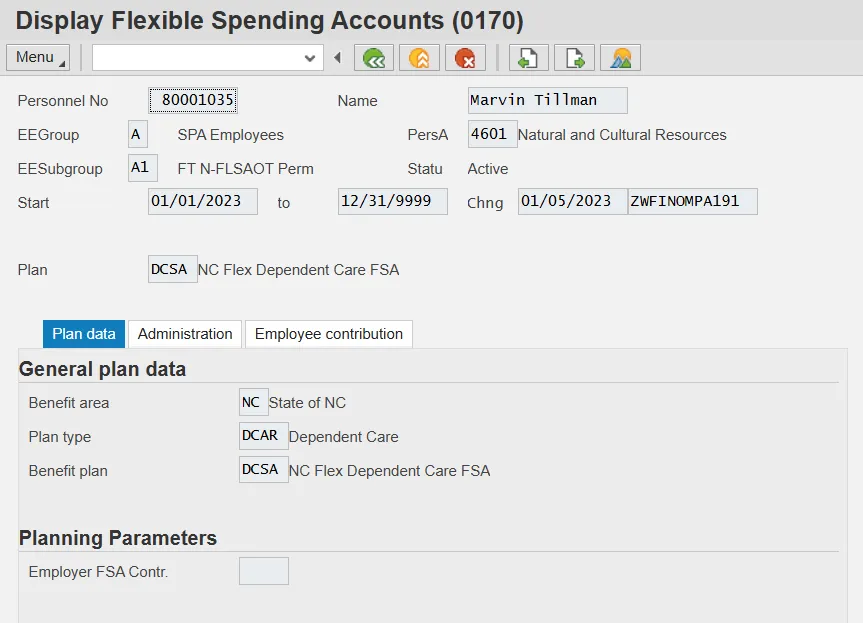
This infotype stores details of the Flexible spending accounts (FSAs) in which the employee is enrolled. For each FSA in which the employee participates, a separate record exists.
Note: Usually, changes will not be made to this infotype. It is created automatically and updated by enrollment procedures.
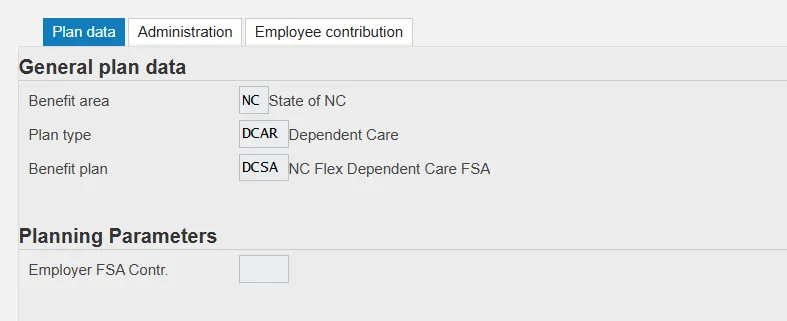
The Plan data tab shows how the plan fits into your benefit structure. It stores the employer contribution rule variant for the plan.

The Administration data tab is created by the system at enrollment. It shows the eligibility status for the plan.

The Employee contribution tab shows the annual pre-tax contribution made on regular payroll runs.
General Benefits Data (IT0171)
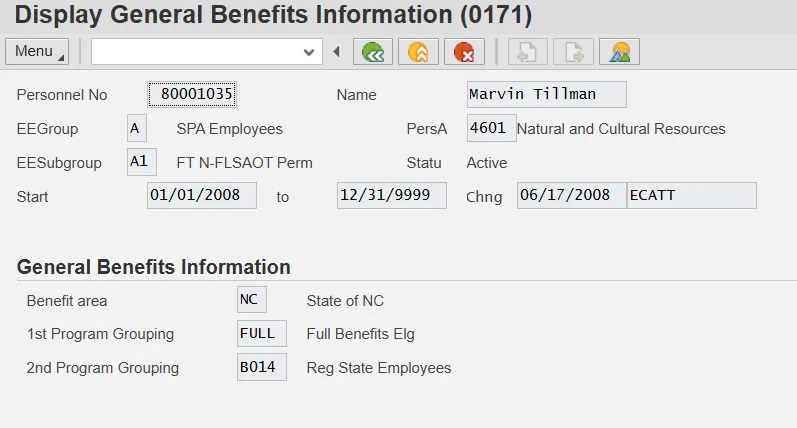
This record is essential for benefits processing. An employee must have a General Benefits Information record before enrolling in a benefits plan.
Field Definitions
| Field Name | Description | |
| Benefits area | This field specifies the highest-level subdivision of benefits data which is State of North Carolina. Always select NC for State of North Carolina. | |
| 1st Programming Grouping |
A first program grouping is a means of identifying a group of employees with common characteristics in order to determine on a high level the benefit program available for that group (macro-eligibility). The system sorts employees into first program groupings during processing, according to the corresponding feature. These three groups have been defined:
|
|
| 2nd Programming Grouping | A second program grouping is a means of identifying a group of employees with common characteristics in order to determine on a high level the program of benefit plans available for that group (macro-eligibility). The system sorts employees into second program groupings during processing, according to the corresponding feature. Fourteen agency/department groups have been identified. |
Health Plans – Overview (IT0167)
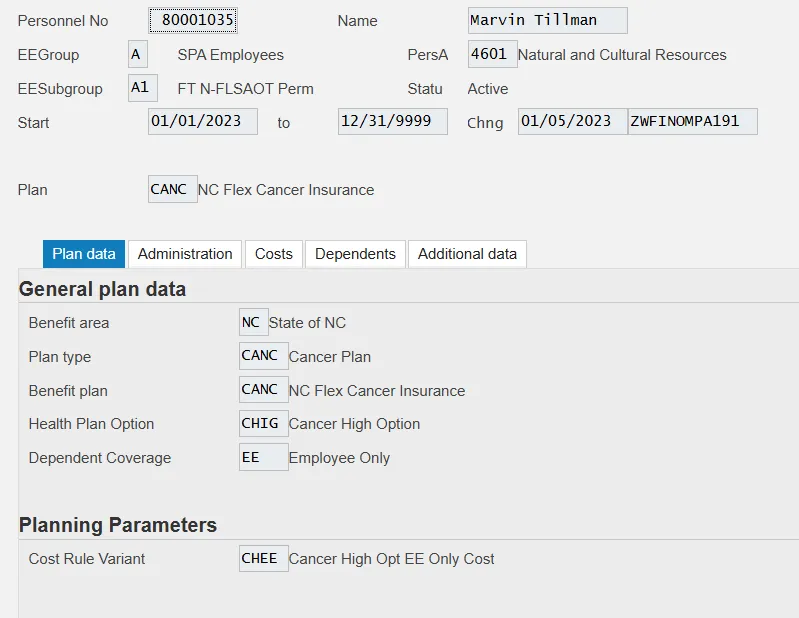
This infotype stores details of the health plans in which the employee is enrolled. For each health plan in which the employee participants, a separate record exits. The following four subtypes have been defined:
- CANC – Cancer
- DENT – Dental
- MEDI – Medical
- VIS – Vision
The tabs being used by the Integrated HR/Payroll System are:
- Plan data
- Administration
- Costs
- Dependents
- The Additional data tab is not being used by the Integrated HR/Payroll System
Note: Usually, changes will not be made to this infotype. It is created automatically and updated by enrollment procedures.
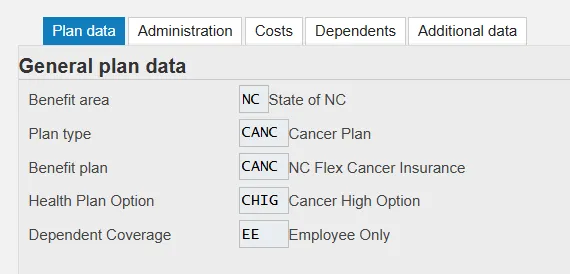
The Plan data tab shows how the plan fits into your benefit structure. It stores the cost rule variant for the plan.
| Field Name | Description | |
| Benefits area | Specifies the highest-level subdivision of benefits data, which is the State of North Carolina. | |
| Plan type |
Specifies a customer-defined subdivision of a plan category. The plan type determines the subtype of the infotype created for a plan. An employee can participate in only one plan of each plan type at any time. The categories are
|
|
| Benefit plan | A four-character identifier for the benefit plan. | |
| Health Plan Option |
The health plan options represent the choices an employee can make about different services within a health plan. Example: The following are medical health plan options:
|
|
| Dependent Coverage |
This is the scope of dependent coverage. It shows which of the employee's dependents are covered under the health plan. For example, the dependent coverage options for the SMCB (Smart Choice Basic 70/30) medical plan are
NOTE: The dependent coverage options that are displayed will be specific to the selected health plan option. |
|
| Cost Rule Variant | A cost variant is a group of settings that determine which criteria influence the cost of a plan for an employee and how employees are grouped for the calculation of cost. |
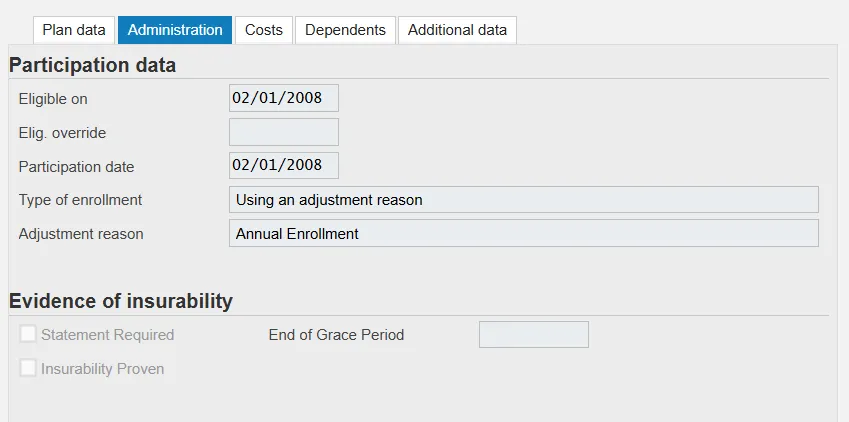
The Administration tab is created by the Integrated HR/Payroll System at enrollment. It shows the status of evidence of insurability requirements for a health plan. Only Cancer and Life Insurance requires evidence of insurability.
NOTE: If an employee wants to add Cancer, change from the low Cancer option to the high Cancer option, or add Life Insurance over $100K, during an open enrollment period not associated with his or her new hire action, an adjustment reason is needed.
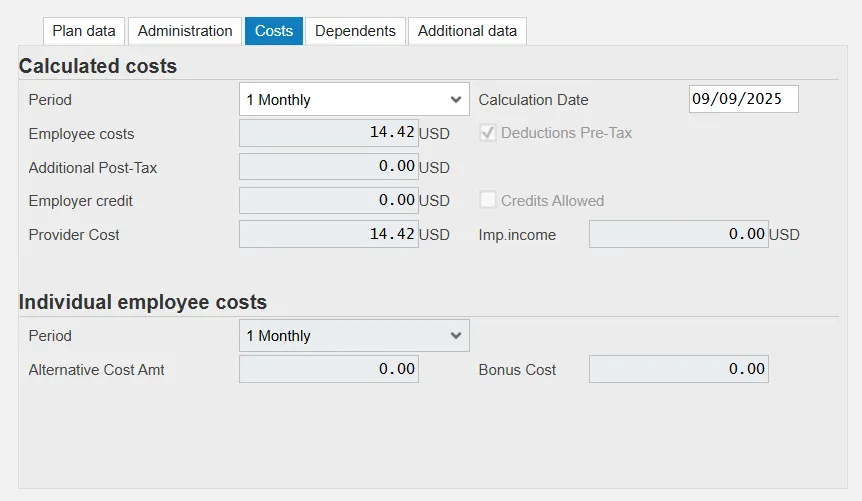
The Costs tab shows the automatically generated employer and employee plan costs. The Integrated HR/Payroll System controls the cost information.
Important note: For employees assigned to the biweekly pay period, as denoted in the Payroll Status field, the cost displayed by the system in this tab is calculated for 26 bi-weekly pay periods per year. The State’s actual calculation of cost is based on a 24 bi-weekly pay periods per year. In other words, this tab does not display the actual costs.
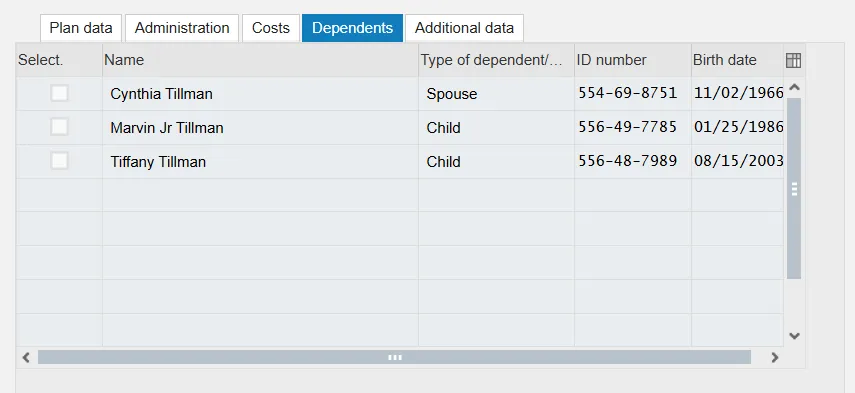
The Dependent tab lists the possible dependents for the plan. The dependents chosen by the employee are marked here in the Select indicator.
Insurance Plans – Overview (IT0168)
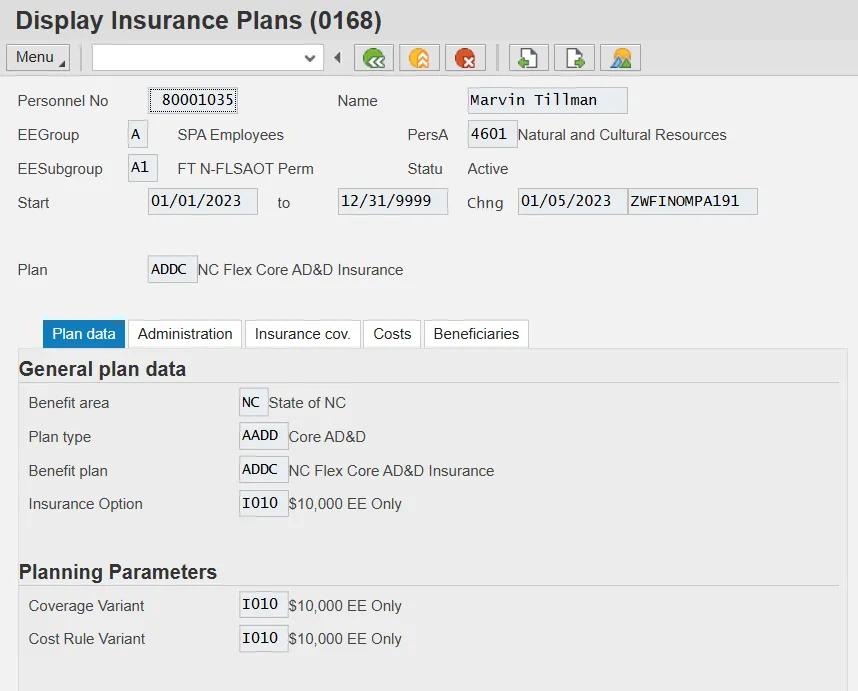
This infotype stores details of the insurance plans in which the employee is enrolled. The two subtypes are Life insurance and AD&D.
For each insurance plan in which the employee participates, a separate record exists. The infotype is used for payroll and for evaluations of employee benefits data.
Note: Usually, changes will not be made to this infotype. It is automatically created and updated by enrollment procedures.
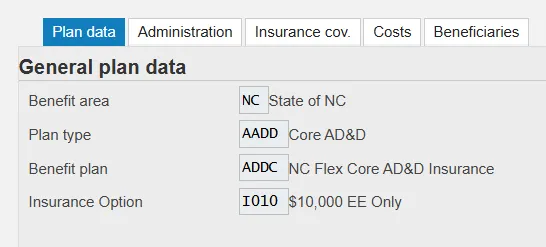
The Plan data tab shows how the plan fits into your benefit structure. It stores the cost and coverage rule variants for the plan.
| Field Name | Description | |
| Benefits area | Specifies the highest-level subdivision of benefits data, which is the State of North Carolina. | |
| Plan type |
Specifies a customer-defined subdivision of a plan category. The plan type determines the subtype of the infotype created for a plan. An employee can participate in only one plan of each plan type at any time. The categories are:
|
|
| Benefit Plan | A four-character identifier for the benefit plan | |
| Insurance Option |
This is the insurance plan option, within the insurance plan. Example: The AD&D has 24 options, which the employee selects the desired coverage from. |
|
| Coverage Variant | A coverage variant is a group of settings that determine which criteria influence plan coverage for an employee and how employees are grouped for the calculation of coverage amounts. | |
| Cost Rule Variant | A cost variant is a group of settings that determine which criteria influence the cost of a plan for an employee and how employees are grouped for the calculation of cost. |
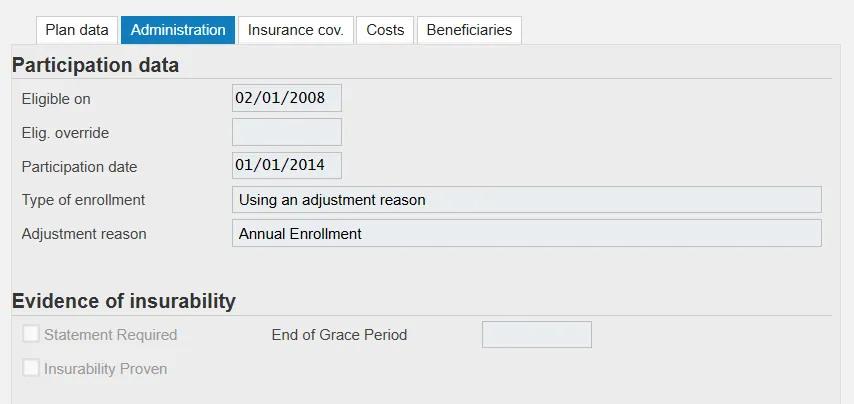
The Administration tab is created by the system at enrollment. It shows the evidence of insurability requirements for the plan.
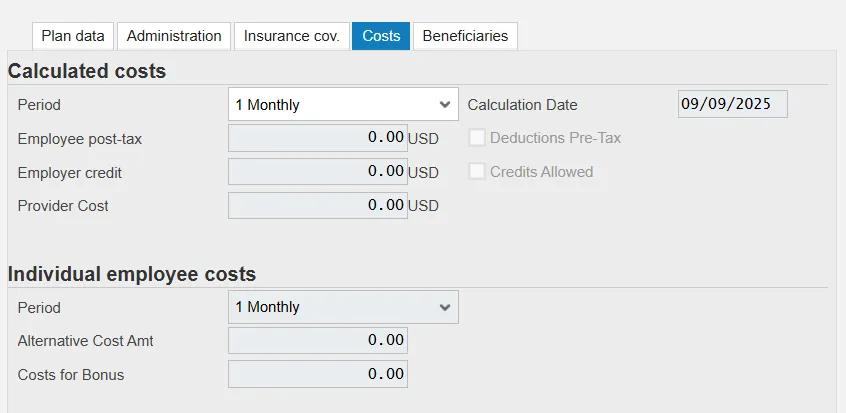
The Costs tab shows the automatically generated employer and employee plan costs.
NOTE: When an EOI is pending, the additional coverage amount will display in the Alternative Coverage field.
The Dependents tab shows the possible beneficiaries for the plan and the payout percentage chosen by the employee.
Miscellaneous Plans (IT0377)
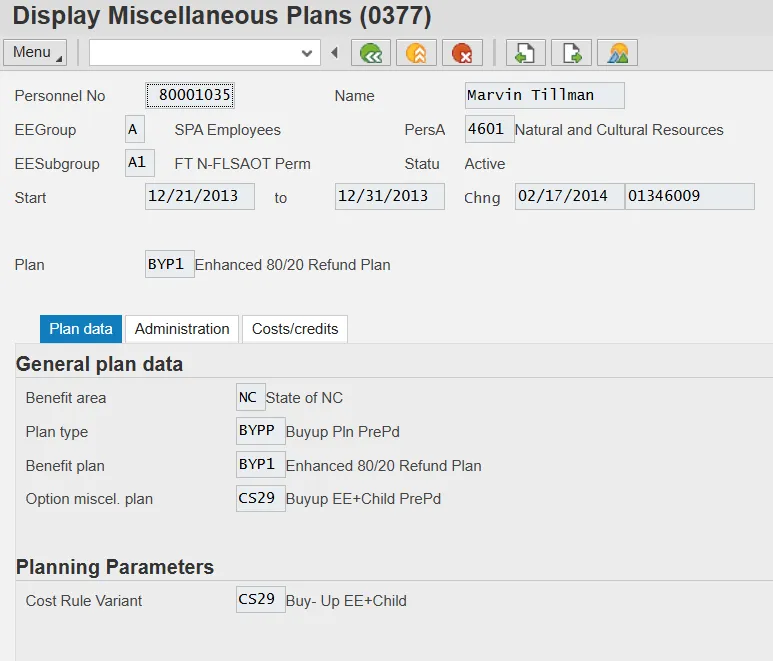
The Miscellaneous Plans infotype is created automatically when an employee enrolls in an SHP (State Health Plan) as the mechanism to collect the prepaid premium for the first enrollment month. For example, if an employee is hired 6/19/11 and has selected to start the SHP plan on 8/01/11, then the validity dates for this infotype will be 7/01/11 to 07/31/11 to collect the prepaid premium for the first month of enrollment in the plan. Subsequent premiums will occur automatically as a payroll deduction.
This infotype is created automatically through a nightly batch processing job based on that day’s enrollment.
Note: Usually, you should not need to make any changes to this infotype. It is automatically created and updated by enrollment procedures.
Savings Plans – Overview (IT0169)
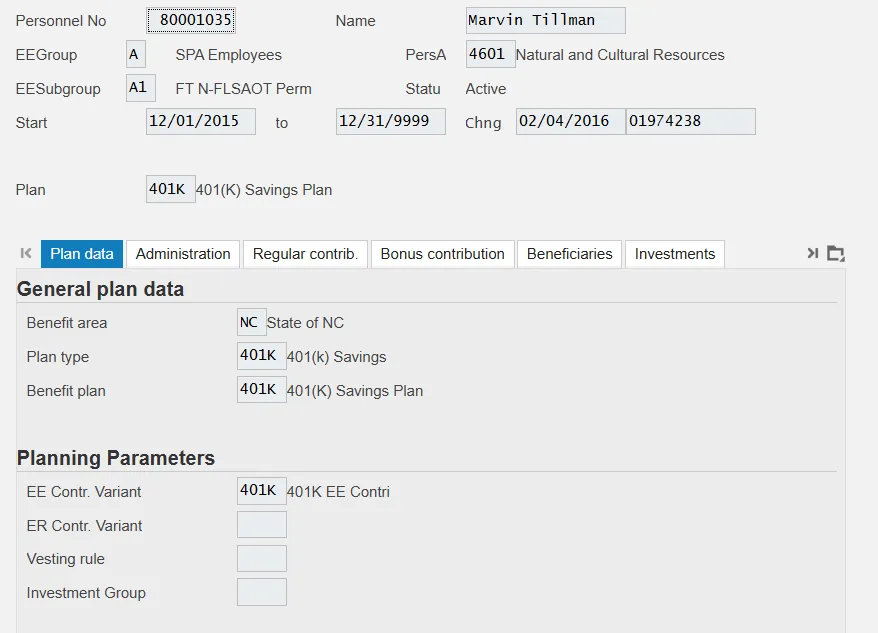
This infotype stores details of the savings plans in which the employee is enrolled. For each savings plan in which the employee participates, a separate record exists. The infotype is used for payroll and for evaluations of employee benefits data.
The State of North Carolina offers these voluntary saving plans: 401(k), 401(k) Roth, 403b for some agencies and 457.
The State of North Carolina offers these retirement plans:
- TSERS (Teachers’ and State Employee Retirement System
- LEORS (Law Enforcement Officer Retirement System)
- CJRS (Consolidated Judicial Retirement System)
- ORP (Optional Retirement Plan) only at NC School of Science and Math
Note: Usually, changes will not be made to this infotype. It is automatically created and updated by enrollment procedures.
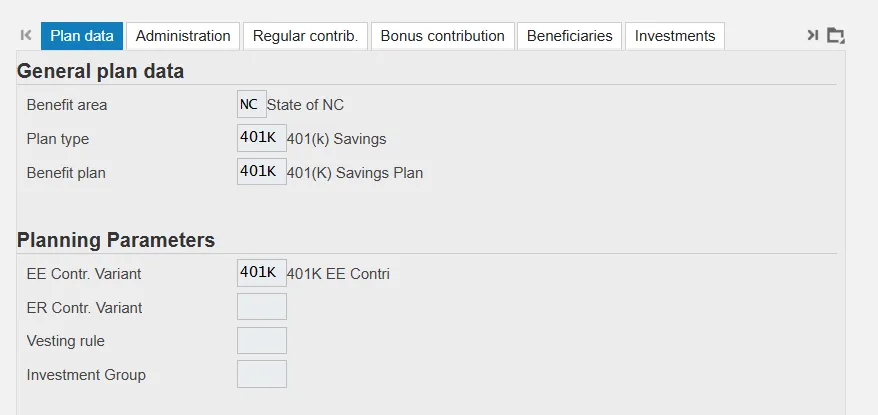
The Plan data tab shows how the plan fits into your benefit structure. It stores the contribution rule variants, vesting rules, and investment group for the plan.
| Field Name | Description | |
| Benefits area | Specifies the highest-level subdivision of benefits data, which is the State of North Carolina. | |
| Plan type |
Specifies a customer-defined subdivision of a plan category. The plan type determines the subtype of the infotype created for a plan. An employee can participate in only one plan of each plan type at any time. The categories are:
|
|
| Benefit Plan | A four-character identifier for the benefit plan. | |
| EE Contribution Variant | An employee contribution variant is a group of settings that determine which criteria influence an employee's contribution to a plan and how employees are grouped for the calculation of contribution amounts. | |
| ER Contribution Variant | An employer contribution variant is a group of settings that determine which criteria influence an employee's contribution to a plan and how employees are grouped for the calculation of contribution amounts. | |
| Vesting rule | This is the name of the vesting rule. Under each vesting rule there are vested portions. | |
| Investment group | The investment group represents several investments. You can then assign an investment group to a Savings plan, to provide the investment choices for employees. |
The Administrative data tab is created by the system at enrollment. It shows the eligibility status for the plan.

The Regular contribution tab shows the contribution made on regular payroll runs.
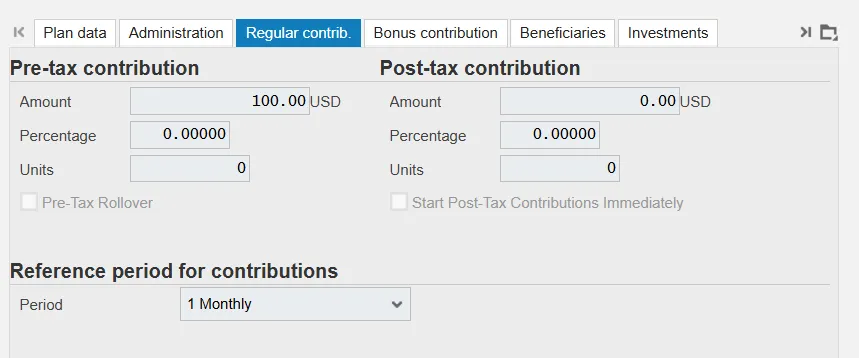
The Bonus contribution tab shows the contribution made only on a bonus payroll run.

The following tabs on the Savings Plans infotype are not being used by the Integrated HR/Payroll System:
- Beneficiaries tab
- Investments tab
- Additional data
Supplemental Benefits
Agency-specific benefits will be processed using one of these two payroll infotypes:
Recurring Payments/Deductions, IT0014 - You can enter an amount and/or a value and a unit of measurement for a wage type that is always paid or deducted during payroll accounting. Recurring Payments or deductions are wage elements that are not paid or deducted in every payroll period. In contrast to additional payments, recurring payments/deductions are paid or deducted with a defined periodicity.
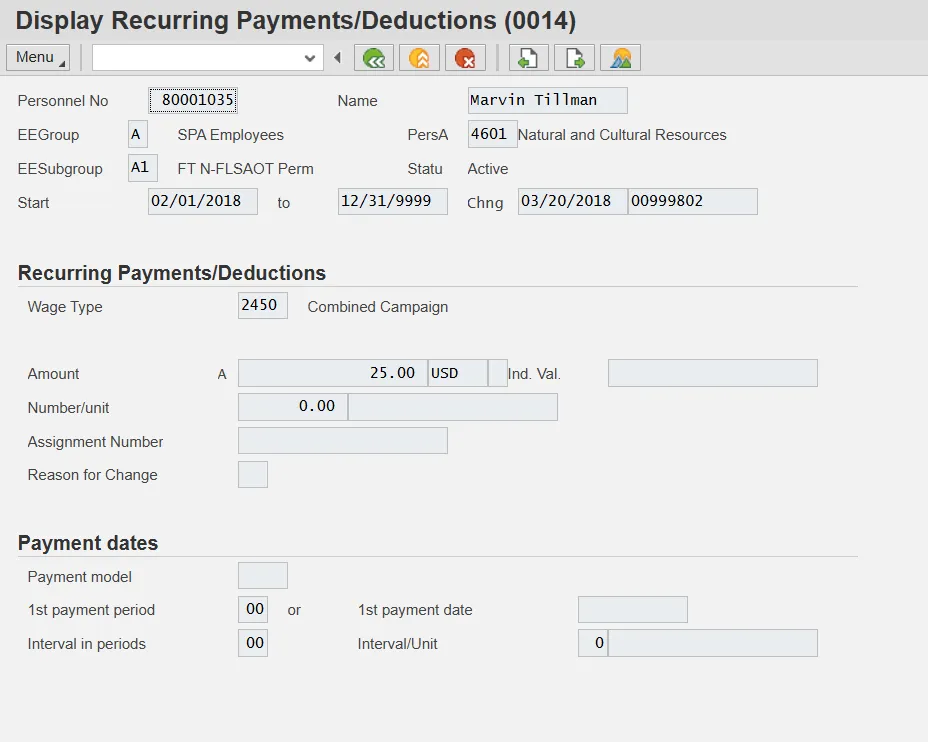
Additional Payments, IT0015 - You can store an amount and/or a value and a unit of measurement that should be paid or deducted in a certain period by Payroll. Additional payments are wage elements which are not paid or deducted in every payroll period in contrast to recurring payments and deductions which are paid or deducted within a defined period.
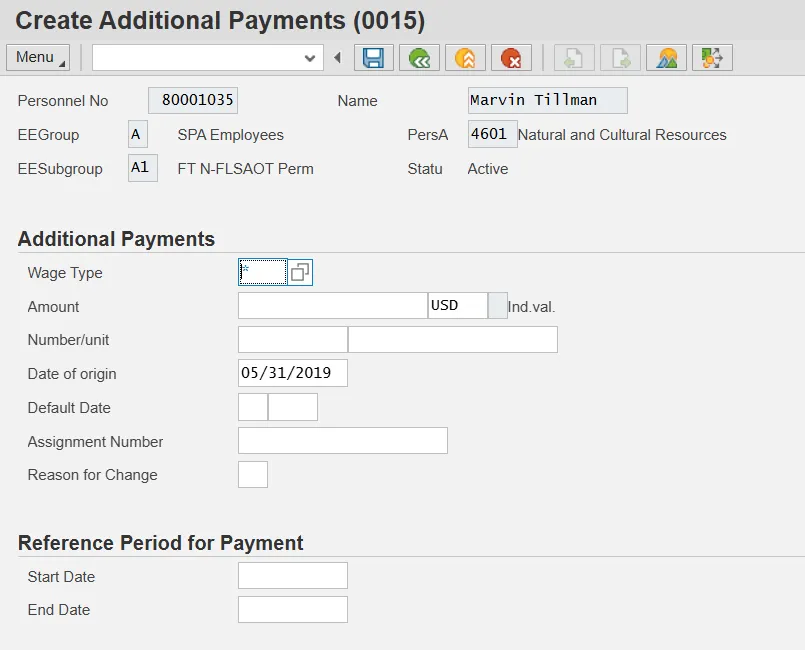
Note: For more information about maintaining these infotypes, please refer to the PY300 - Maintain Payroll course.